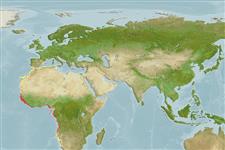Classification / Names
Common names from other countries
Main reference
Size / Weight / Age
Max length : 50.0 cm TL male/unsexed; (Ref. 5377); common length : 30.0 cm TL male/unsexed; (Ref. 3659)
Length at first maturity
Lm 11.6 range ? - ? cm
Environment
Marine; brackish; demersal; depth range 10 - 70 m (Ref. 10799)
Climate / Range
Subtropical, preferred 25°C (Ref. 107945); 37°N - 27°S, 19°W - 16°E (Ref. 57343)
Distribution
Eastern Atlantic: West African coasts, from Canary Islands and Morocco to Angola (Ref. 57402). Sporadically known from Algeria and Namibia (Ref. 57343). Record from Mauritius is likely to be erroneous.
Countries | FAO areas | Ecosystems | Occurrences | Introductions
Short description
Dorsal
spines
(total): 9;
Dorsal
soft rays
(total): 13-14. Diagnosis: 9-10 short detached pectoral filaments, not exceeding length of upper pectoral fin; body moderately elongate and compressed, its height comprised 2.9-3.4 times in standard length; snout very short, blunt and prominent; mouth inferior; posterior edge of maxillary only slightly expanded, barely reaching past eye; 2 widely separated dorsal fins, 1st with 8 spines, 2nd with 1 flexible spine and 13-14 soft rays; 2nd
dorsal fin and anal fin bases barely equal; pectoral fin inserted low on body; scales ctenoid; head and unpaired fins partly covered with small scales (Ref. 57402).
Coloration: body uniformly silvery, upper part greyish and belly white; a large rounded black spot, about equal to eye diameter, generally visible under lateral line, behind opercle (Ref. 57402).
IUCN Red List Status (Ref. 115185)
Threat to humans
Harmless
Human uses
Fisheries: commercial
More information
ReferencesAquacultureAquaculture profileStrainsGeneticsAllele frequenciesHeritabilityDiseasesProcessingMass conversion
Tools
Special reports
Download XML
Internet sources
Estimates of some properties based on models
Phylogenetic diversity index
PD50 = 1.0000 many relatives (e.g. carps) 0.5 - 2.0 few relatives (e.g. lungfishes)
Trophic Level
3.6 ±0.67 se; Based on food items.
Resilience
Medium, minimum population doubling time 1.4 - 4.4 years (K=0.14-0.4)
Vulnerability
Low to moderate vulnerability (30 of 100)
Price category
